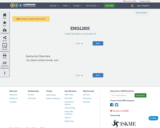
THE ORIENT EXPRESS RHYME AISD
- Subject:
- Reading Literature
- Material Type:
- Reading
- Author:
- Robert Majure
- Date Added:
- 11/15/2021

THE ORIENT EXPRESS RHYME AISD

This resource is for English 16 U.S. Literature. This course "engages questions of place, gender, and race, and examines American experiences and American cultural production."Materials include a syllabus, open pedagogy assignment Literary Artifact which was co-created with students, and student examples.

Word Count: 529873
(Note: This resource's metadata has been created automatically by reformatting and/or combining the information that the author initially provided as part of a bulk import process.)

This is a Reading Material on Digital Education
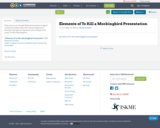
This resource is a Google Slides presentation designed to educate students about five various elements of literature that play an important role in Harper Lee's novel, To Kill a Mockingbird.

Published in English in 1960, Elie Wiesel’s Night is an autobiographical account of his experience in the Nazi concentration camps of Auschwitz and Buchenwald from 1944-1945.
(Digital Public Library of America (DPLA) Primary Source Sets are designed to help students develop critical thinking skills by exploring topics in history, literature, and culture through primary sources. Drawing online materials from libraries, archives, and museums across the United States, the sets use letters, photographs, posters, oral histories, video clips, sheet music, and more. Each set includes a topic overview, ten to fifteen primary sources, links to related resources, and a teaching guide.)
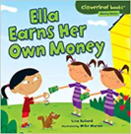
Within this collection you will find lessons, videos, handouts, and teacher guides you can use in your classroom. You will also find a brief summary of each resource with the source sited for further exploration, appropriate grade level, approximate lesson length, and learning standards.
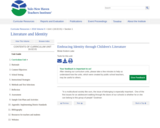
This unit was developed for middle school students but may be adapted for elementary or high school students. The unit is focused on language arts, social emotional and behavioral standards. The activities and lessons included in this unit explore themes of identity. Using multicultural children’s literature, this unit will encourage participants to have honest and courageous conversations regarding race, culture, and socio economic identity. The activities in this unit have been created to boost a sense of belonging and acceptance by breaking down stereotypes in order to build a positive school community. The unit includes hands on activities and celebrates individual as well as group identities.
The time frame for this unit is nine weeks. Included in this unit are lesson plans and reading lists for teachers and students. Different hands-on activities are also recommended.
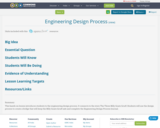
This hands-on lesson introduces students to the engineering design process. It connects to the story The Three Billy Goats Gruff. Students will use the design process to create a bridge that will keep the Billy Goats Gruff safe and complete the Engineering Design Process Journal.

Thank you for visiting our Tennessee Board of Regents OER Grant English 1020: Introduction to Literature course. The pilot launched in spring 2023. This Walters State Community College composition course focuses on reading and analyzing poetry, drama, and short stories. The course has been designed with Quality Matters standards, Universal Design for Learning concepts, Growth Mindset fundamentals, and Lumen Circles concepts.

In this unit, students will take a look at the historical vision of the American Dream as put together by our Founding Fathers. They will be asked: How, if at all, has this dream changed? Is this dream your dream? First students will participate in an American Dream Convention, acting as a particular historical figure arguing for his or her vision of the American Dream, and then they will write an argument laying out and defending their personal view of what the American Dream should be.
ACCOMPLISHMENTS
Students read and annotate closely one of the documents that they feel expresses the American Dream.
Students participate in an American Dream Convention, acting as a particular historical figure arguing his or her vision of the American Dream.
Students write a paper, taking into consideration the different points of view in the documents read, answering the question “What is the American Dream now?”
Students write their own argument describing and defending their vision of what the American Dream should be.
GUIDING QUESTIONS
These questions are a guide to stimulate thinking, discussion, and writing on the themes and ideas in the unit. For complete and thoughtful answers and for meaningful discussions, students must use evidence based on careful reading of the texts.
What has been the historical vision of the American Dream?
What should the American Dream be? (What should we as individuals and as a nation aspire to?)
How would women, former slaves, and other disenfranchised groups living during the time these documents were written respond to them?
BENCHMARK ASSESSMENT: Cold Read
During this unit, on a day of your choosing, we recommend you administer a Cold Read to assess students’ reading comprehension. For this assessment, students read a text they have never seen before and then respond to multiple-choice and constructed-response questions. The assessment is not included in this course materials.

In this lesson, students will share their work with their classmates and celebrate their accomplishments.

In this 5-day unit, students will explore the topic of cheating. Cheating seems to be ever-present in today’s society. Whether we are talking about athletes being busted for using steroids or students “sharing” answers and plagiarizing on final exams, one thing is clear—there’s a whole lot of cheating going on. In this unit, students will take a look at some contemporary instances of cheating and argue whether under certain situations cheating is not only excusable, but also justifiable.

In this lesson, students will share annotations and discuss the articles “Don’t Alter Models’ Bodies” and “Is Photoshop Destroying America’s Body Image?” Then they will write an argument in which they state their claim, present relevant evidence, and respond to counterarguments.

In this lesson, you will take the writing portion of the culminating assessment. You will continue to use the skills you have learned in the first three lessons of this unit.Today, students will take the writing portion of the culminating assessment.They will reflect on all the material they have read in this unit, and they will use their understanding of all the material presented to them to write an essay. You will evaluate their work in both reading comprehension and writing.

This unit uses William Shakespeare’s Much Ado About Nothing as a vehicle to help students consider how a person is powerless in the face of rumor and how reputations can alter lives, both for good and for ill. They will consider comedy and what makes us laugh. They will see how the standards of beauty and societal views toward women have changed since the Elizabethan Age and reflect on reasons for those changes. As students consider the play, they will write on the passages that inspire and plague them and on topics relating to one of the themes in the play. Finally, they will bring Shakespeare’s words to life in individual performances and in group scene presentations.
ACCOMPLISHMENTS
Students read Shakespeare’s Much Ado About Nothing .
Students read two Shakespearean sonnets and excerpts from an Elizabethan morality handbook dealing with types of women, and they respond to them from several different perspectives.
For each work of literature, students do some writing. They learn to write a sonnet; create a Prompt Book; complete a Dialectical Journal; and write an analytical essay about a topic relating to a theme in the play.
Students see Shakespeare’s play as it was intended to be seen: in a performance. They memorize 15 or more lines from the play and perform them for the class. Students take part in a short scene as either a director or an actor.
GUIDING QUESTIONS
These questions are a guide to stimulate thinking, discussion, and writing on the themes and ideas in the unit. For complete and thoughtful answers and for meaningful discussions, students must use evidence based on careful reading of the texts.
What are society’s expectations with regard to gender roles?
Does humor transcend time? Do we share the same sense of humor as our ancestors?
How do we judge people?
How important is reputation?
BENCHMARK ASSESSMENT (Cold Read)
During this unit, on a day of your choosing, we recommend you administer a Cold Read to assess students’ reading comprehension. For this assessment, students read a text they have never seen before and then respond to multiple-choice and constructed-response questions. The assessment is not included in this course materials.
CLASSROOM FILMS
The Branagh version of Much Ado About Nothing is available on DVD through Netflix and for streaming through Amazon. Other versions are also available on both sites.

In this lesson, students will revise the final couplet of their sonnet, learn more about the characters in Much Ado About Nothing, and begin their Dialectical Journal. Finally, they will use their developing understanding of iambic pentameter to analyze Shakespeare’s language choices.
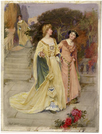
In this lesson, students will come to see how the concept of deception can be looked at in more than one way and how this factors into Much Ado About Nothing ’s character development.

In this lesson, students will take a closer look at the villain of this play. Is Don John really so evil? Has evil been done to him? Then they’ll learn about Dogberryisms and see whether they can interpret some of them themselves.
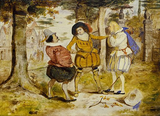
In this lesson, students will continue reading Much Ado About Nothing aloud and then compare and contrast the directorial choices made in two staged versions of act 2, scene 3.